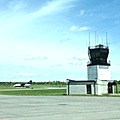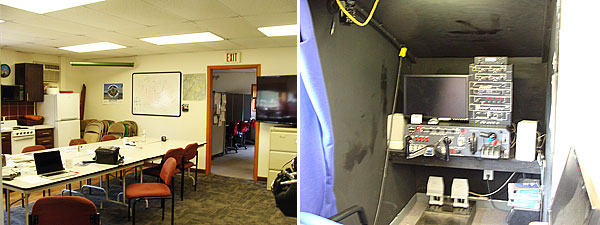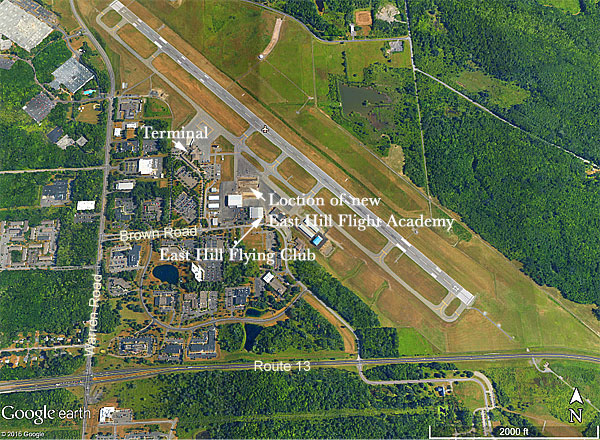- By Dan Veaner
- Around Town
 Print
Print  Growing Ithaca-Tompkins Regional Airport
Growing Ithaca-Tompkins Regional AirportOn June 8th Governor Andrew M. Cuomo announced $10 million has been awarded for airport capital project improvements in 20 airports across New York State, including $619,935 to the Ithaca Tompkins Regional Airport for construction of a flight academy building. The new building will be a major part of the transition from East Hill Flying Club (EHFC) to East Hill Flying Academy. Airport Manager Mike Hall says that will bring more people to learn to fly and help grow the airport.
"We've been very fortunate to receive a grant to relocate East Hill Flying Club and morph it into the East Hill Flight Academy," Hall says. "East Hill Flying Club, the busiest flight school in the state, will become a flight academy. The funding will be used to build a new facility and East Hill Flying Club will vacate its current home, which could be rented to a new tenant."

East Hill Flying Club Manager/Chief Instructor Mike Thomas says the new building will provide a much needed upgrade that he thinks will attract more people to Ithaca to get their pilot training. A few years ago the club purchased the nearby IDI hangar, which will replace the club's current hangar. The new building will provide more teaching space that Thomas hopes will include a full motion flight simulator, more instructional space, and room to increase the size of the fleet of planes the club uses for training and to rent to club members. While the club currently offers twin engine training, they have to use a plane from another airport. Thomas says he hopes to acquire a twin engine plane at some time in the future in order to increase that area of training.
"We've always been an academy in the sense that we are an (FAA Part 141) accredited school," Thomas says. "We are overseen by the FAA and we have to follow a strict syllabus. It's worked very well for us for over 60 years. We want to carry that forward, maybe to the next level with a new building. Hopefully we will have a full motion simulator, and possibly more planes in our fleet. Other than that the training will remain much the same in that we are a very thorough training center."
Thomas says that the quality of training makes EHFC unique and especially desirable for pilots who plan to fly in the private sector or for charter companies. Many flying schools offer the minimum required to obtain a private pilot license and instrument and commercial ratings, figuring their students will get further training they need from the airlines once they have been hired. While pilots who want to stay within the general aviation sector can get by with such training, Thomas says it is much safer when they are better prepared.
"Although we follow the same rules, our training is usually much more thorough," Thomas says. "We train to the same standard, but we also assume that the pilots are going to go out and actually fly general aviation aircraft with their families in all kinds of conditions -- in busy airspace, in the clouds. If you're going to be a pilot you have to be well trained and you have to be immersed in a safety culture where you personal minimums, you know how to assess risk, and you know what the airplane can do and the pilot can do. You carry that forward through your whole career."
Another advantage is that EHFC is non-profit, which means their members can fly at cost. And Thomas notes that many times for-profit flight schools simply can't make it.
"Horror stories abound about schools that need $20,000 down and the student gets there and the school has disappeared," he observes.
 The old building is outdated and crowded. A desktop flight simulator (right) is crammed into a small carrel space with a stack of aviation radios piled on top of it. It hasn't helped that the facility has been flooded more than once over the years.
The old building is outdated and crowded. A desktop flight simulator (right) is crammed into a small carrel space with a stack of aviation radios piled on top of it. It hasn't helped that the facility has been flooded more than once over the years.The grant money for the building goes to the airport itself, but the purpose is to enhance the airport and aviation itself. That means that East Hill Flying Academy's success will be an important piece of the airport's success. As such, EHFC members are beginning to think about what they want the building to look like in order to accomplish that mission. It is still in the early stage, but Thomas has some ideas about how the building can make his training program more effective.
"I would envision a common area like we have, and some separate rooms for private training," he says. "The Redbird full motion simulator will have to have a room to itself. It takes up quite a bit of room. And maybe have a room dedicated to audio visual with several white boards and training props. I would like more private training rooms than this facility has. Our hope is we're going to have a nice, modern facility. This one has been here for 60-plus years and it's seen its day."
 Chief Pilot instructor and Club Manager Mike Hall hopes to be able to aquire a full motion simulator once the new building is completed. Photo courtesy of Redbird Flight Simulations, Inc.
Chief Pilot instructor and Club Manager Mike Hall hopes to be able to aquire a full motion simulator once the new building is completed. Photo courtesy of Redbird Flight Simulations, Inc.The simulator he is talking about looks a bit like an amusement park ride. A pilot gets inside what looks like a science fiction space shuttle pod. The pod contains a full airplane cockpit, and as the pilot maneuvers the 'plane' the pod moves to simulate what a pilot would feel in a real airplane. It is the closest a student pilot can get to flying without actually flying.
Both Hall and Thomas note there is a commercial airline pilot shortage. Hall says the shortage has worked against the local airport. Ithaca has the capacity for more arrivals and departures, and he says Ithaca is the most reliable airport in upstate New York. But he says that flying a 400-seat plane from Los Angeles to New York is a lot more lucrative than a 30 or 40 seat plane from Philadelphia to Ithaca because the airlines can sell more seats on a flight with a much more favorable equipment and crew to passenger ratio. When you add a pilot shortage to that equation, Hall says the airlines are opting for more flights to big hubs and fewer to regional airports like Ithaca-Thompkins.
"The thing that we're fighting from a regional point of view is system saturation in various places," he says. "The fact that we've got a nationwide pilot shortage that's getting worse, and the fact that the airlines, in response to this trend, have continually up-gauged their airplanes."
To combat that, Hall is lobbying airlines to schedule Ithaca flights to larger, less saturated hubs that are also less susceptible to bad weather. That works well for Ithaca-Detroit flights that Delta offers now. Hall says the result is that flights leave and arrive on time much more often than United and American's flights to Philadelphia and Newark. About 180,000 people travel to and from Ithaca-Tompkins Regional Airport each year. Hall says he has is no doubt that number could be doubled if more commercial flights were available.
"Newark and Philly are sort of intractable -- there's not much you can do about northeast corridor weather and traffic," he says. "It's going to be tougher and tougher to get volume service into northeast hubs that are already congested, particularly when the stage length is quite short for a jet. That's why the turboprops are on the runs right now. They're a more efficient design for that short stage length, but nobody's building turboprops, so something's got to happen. We're suggesting that they could relieve some of the congestion at those hubs by taking us to equally well connected hubs that are a little further away, like Chicago and Charlotte, for example."
 Ithaca-Thompkins Regional Airport has a 6,977 foot long runway. On top of commercial flights the tower-controlled airport includes East Hill Flying Club for training and airplane rentals, and fixed base operator (FBO) Taughannock Aviation, which operates a charter service and provides maintenance on private planes. The airport also has a lot of private traffic from business aircraft, often from other countries, that service businesses at the adjoining business and technology park and elsewhere in the Ithaca area.
Ithaca-Thompkins Regional Airport has a 6,977 foot long runway. On top of commercial flights the tower-controlled airport includes East Hill Flying Club for training and airplane rentals, and fixed base operator (FBO) Taughannock Aviation, which operates a charter service and provides maintenance on private planes. The airport also has a lot of private traffic from business aircraft, often from other countries, that service businesses at the adjoining business and technology park and elsewhere in the Ithaca area.On top of lobbying the airlines, Hall is aggressively pursuing grants to improve both safety and travelers' experience in the 22 year old terminal. One possible future project is to improve the flow of passengers through security, widening the entrance to the departure and arrival areas so that pre-cleared TSA flyers can go through an expedited clearance line. Another may be to add a customs facility so flights originating in foreign countries don't have to stop at another airport for customs processing before continuing their journey to Ithaca.
Current projects funded by grant money include a $4.3 million runway repaving and the upcoming $619,935 academy building. Of course the academy building grant has only just been announced, so the money and specific building plans are in the future. Thomas estimates it will be another two or three years before the building is completed.
Hall and Thomas believe the increased capacity will bring more students. That will not only contribute to filling the pilot shortage, but will bring more general aviation use to the airfield. Hall says the airport has the strongest general aviation component in Central New York by a good measure, and sees East Hill Flying Club's evolution into a flying academy as a way to grow.
Thomas certainly isn't against growth of his school, but says that maintaining safety and high standards are his goals, not recruitment. But he adds that keeping those values and expanding the school's physical capacity will naturally attract more pilots.
 Club Manager and 141 Chief Instructor Mike Thomas in front of part of the East Hill Flying Club fleet of training aircraft
Club Manager and 141 Chief Instructor Mike Thomas in front of part of the East Hill Flying Club fleet of training aircraft"I see a demand out there," Thomas says. "I know it's going to grow on its own. I'm not going to proactively try to find X amount of bodies to fill this new building. I think that will come of itself. My job is to protect my members and airplanes and keep the same level of professionalism. So we want to continue with that same model and that same mission and maybe incorporate people from out of the area and make it more encompassing instead of just a local training school."
The airport reopens to commercial flights Monday, starting with a 9am ribbon cutting that begins a 'Client Appreciation Week'. Visitors to the airport -- not just passengers -- will receive free food and a chance to win prizes that will include tickets and gift certificates for local business, airline vouchers, and, of course, celebratory flights sponsored by East Hill Flying Club. That last one is the one to win, of course, because an introductory flight in a general aviation aircraft is all it takes to spark your desire to learn to fly.
v12i28


